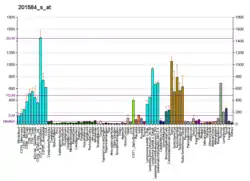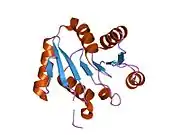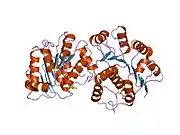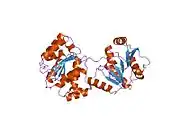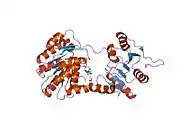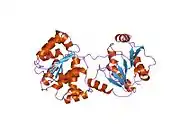DDX39
ATP-dependent RNA helicase DDX39 is an enzyme that in humans is encoded by the DDX39 gene.[5][6]
| DDX39A | |||||||||||||||||||||||||||||||||||||||||||||||||||
|---|---|---|---|---|---|---|---|---|---|---|---|---|---|---|---|---|---|---|---|---|---|---|---|---|---|---|---|---|---|---|---|---|---|---|---|---|---|---|---|---|---|---|---|---|---|---|---|---|---|---|---|
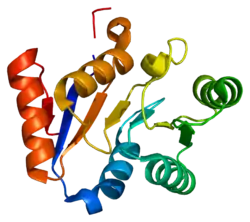 | |||||||||||||||||||||||||||||||||||||||||||||||||||
| Identifiers | |||||||||||||||||||||||||||||||||||||||||||||||||||
| Aliases | DDX39A, BAT1, BAT1L, DDX39, DDXL, URH49, DEAD-box helicase 39A, DExD-box helicase 39A | ||||||||||||||||||||||||||||||||||||||||||||||||||
| External IDs | MGI: 1915528 HomoloGene: 68487 GeneCards: DDX39A | ||||||||||||||||||||||||||||||||||||||||||||||||||
| |||||||||||||||||||||||||||||||||||||||||||||||||||
| |||||||||||||||||||||||||||||||||||||||||||||||||||
| |||||||||||||||||||||||||||||||||||||||||||||||||||
| |||||||||||||||||||||||||||||||||||||||||||||||||||
| |||||||||||||||||||||||||||||||||||||||||||||||||||
| Wikidata | |||||||||||||||||||||||||||||||||||||||||||||||||||
| |||||||||||||||||||||||||||||||||||||||||||||||||||
This gene encodes a member of the DEAD box protein family. These proteins are characterized by the conserved motif Asp-Glu-Ala-Asp (DEAD) and are putative RNA helicases. They are implicated in a number of cellular processes involving alteration of RNA secondary structure, such as translation initiation, nuclear and mitochondrial splicing, and ribosome and spliceosome assembly. Based on their distribution patterns, some members of the DEAD box protein family are believed to be involved in embryogenesis, spermatogenesis, and cellular growth and division.[6]
References
- GRCh38: Ensembl release 89: ENSG00000123136 - Ensembl, May 2017
- GRCm38: Ensembl release 89: ENSMUSG00000005481 - Ensembl, May 2017
- "Human PubMed Reference:". National Center for Biotechnology Information, U.S. National Library of Medicine.
- "Mouse PubMed Reference:". National Center for Biotechnology Information, U.S. National Library of Medicine.
- Peelman LJ, Chardon P, Nunes M, Renard C, Geffrotin C, Vaiman M, Van Zeveren A, Coppieters W, van de Weghe A, Bouquet Y, et al. (Aug 1995). "The BAT1 gene in the MHC encodes an evolutionarily conserved putative nuclear RNA helicase of the DEAD family". Genomics. 26 (2): 210–8. doi:10.1016/0888-7543(95)80203-X. PMID 7601445.
- "Entrez Gene: DDX39 DEAD (Asp-Glu-Ala-Asp) box polypeptide 39".
Further reading
- Andersen JS, Lyon CE, Fox AH, et al. (2002). "Directed proteomic analysis of the human nucleolus". Curr. Biol. 12 (1): 1–11. doi:10.1016/S0960-9822(01)00650-9. PMID 11790298. S2CID 14132033.
- Strässer K, Masuda S, Mason P, et al. (2002). "TREX is a conserved complex coupling transcription with messenger RNA export". Nature. 417 (6886): 304–8. Bibcode:2002Natur.417..304S. doi:10.1038/nature746. PMID 11979277. S2CID 1112194.
- Strausberg RL, Feingold EA, Grouse LH, et al. (2003). "Generation and initial analysis of more than 15,000 full-length human and mouse cDNA sequences". Proc. Natl. Acad. Sci. U.S.A. 99 (26): 16899–903. Bibcode:2002PNAS...9916899M. doi:10.1073/pnas.242603899. PMC 139241. PMID 12477932.
- Lehner B, Semple JI, Brown SE, et al. (2004). "Analysis of a high-throughput yeast two-hybrid system and its use to predict the function of intracellular proteins encoded within the human MHC class III region". Genomics. 83 (1): 153–67. doi:10.1016/S0888-7543(03)00235-0. PMID 14667819.
- Ota T, Suzuki Y, Nishikawa T, et al. (2004). "Complete sequencing and characterization of 21,243 full-length human cDNAs". Nat. Genet. 36 (1): 40–5. doi:10.1038/ng1285. PMID 14702039.
- Pryor A, Tung L, Yang Z, et al. (2004). "Growth-regulated expression and G0-specific turnover of the mRNA that encodes URH49, a mammalian DExH/D box protein that is highly related to the mRNA export protein UAP56". Nucleic Acids Res. 32 (6): 1857–65. doi:10.1093/nar/gkh347. PMC 390356. PMID 15047853.
- Leaw CL, Ren EC, Choong ML (2004). "Hcc-1 is a novel component of the nuclear matrix with growth inhibitory function". Cell. Mol. Life Sci. 61 (17): 2264–73. doi:10.1007/s00018-004-4205-x. PMID 15338056. S2CID 19729441.
- Gerhard DS, Wagner L, Feingold EA, et al. (2004). "The status, quality, and expansion of the NIH full-length cDNA project: the Mammalian Gene Collection (MGC)". Genome Res. 14 (10B): 2121–7. doi:10.1101/gr.2596504. PMC 528928. PMID 15489334.
- Andersen JS, Lam YW, Leung AK, et al. (2005). "Nucleolar proteome dynamics". Nature. 433 (7021): 77–83. Bibcode:2005Natur.433...77A. doi:10.1038/nature03207. PMID 15635413. S2CID 4344740.
- Rual JF, Venkatesan K, Hao T, et al. (2005). "Towards a proteome-scale map of the human protein-protein interaction network". Nature. 437 (7062): 1173–8. Bibcode:2005Natur.437.1173R. doi:10.1038/nature04209. PMID 16189514. S2CID 4427026.
- Kapadia F, Pryor A, Chang TH, Johnson LF (2007). "Nuclear localization of poly(A)+ mRNA following siRNA reduction of expression of the mammalian RNA helicases UAP56 and URH49". Gene. 384: 37–44. doi:10.1016/j.gene.2006.07.010. PMID 16949217.
- Sugiura T, Sakurai K, Nagano Y (2007). "Intracellular characterization of DDX39, a novel growth-associated RNA helicase". Exp. Cell Res. 313 (4): 782–90. doi:10.1016/j.yexcr.2006.11.014. PMID 17196963.
- Quaresma AJ, Sievert R, Nickerson JA (2013). "Regulation of mRNA export by the PI3 kinase/AKT signal transduction pathway". Mol. Biol. Cell. 24 (8): 1208–21. doi:10.1091/mbc.E12-06-0450. PMC 3623641. PMID 23427269.
External links
- DDX39A human gene location in the UCSC Genome Browser.
- DDX39A human gene details in the UCSC Genome Browser.
This article is issued from Wikipedia. The text is licensed under Creative Commons - Attribution - Sharealike. Additional terms may apply for the media files.




